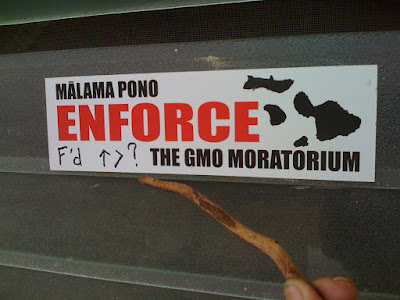Proliferating GMOs could lead to “an irreversible termination of life [on] the planet.”
Risk analyst Nassim Nicholas Taleb predicted the 2008 financial crisis, by pointing out that commonly-used risk models were wrong. Now he points out that most boosters for genetically modified foods (GMOs) – including scientists – are totally ignorant about risk analysis.
http://mrscottyl.blogspot.com/2015/07/expert-who-predicted-2008-financial.html
Risk analyst Nassim Nicholas Taleb predicted the 2008 financial crisis, by pointing out that commonly-used risk models were wrong. Now he points out that most boosters for genetically modified foods (GMOs) – including scientists – are totally ignorant about risk analysis.
http://mrscottyl.blogspot.com/2015/07/expert-who-predicted-2008-financial.html
Risk analyst Nassim Nicholas Taleb predicted the 2008 financial crisis, by pointing out that commonly-used risk models were wrong. Taleb – a distinguished professor of risk engineering at New York University, and author of best-sellers The Black Swan and Fooled by Randomness – Taleb became financially independent after the crash of 1987, and wealthy during the 2008 financial crisis.
Taleb noted last year that most boosters for genetically modified foods (GMOs) – including scientists – are totally ignorant about risk analysis. Taleb said that proliferating GMOs could lead to “an irreversible termination of life [on] the planet.”
This month, Taleb – and tail-
Before the crisis that started in 2007, both of us believed that the financial system was fragile and unsustainable, contrary to the near ubiquitous analyses at the time.
Now, there is something vastly riskier facing us, with risks that entail the survival of the global ecosystem — not the financial system. This time, the fight is against the current promotion of genetically modified organisms, or G.M.O.s.
Our critics held that the financial system was improved thanks to the unwavering progress of science and technology, which had blessed finance with more sophisticated economic insight. But the “tail risks,” or the effect from rare but monstrously consequential events, we held, had been increasing, owing to increasing complexity and globalization. Given that almost nobody was paying attention to the risks, we set ourselves and our clients to be protected from an eventual collapse of the banking system, which subsequently happened to the benefit of those who were prepared.
***
We were repeatedly told that there was evidence that the system was stable, that we were in “the Great Moderation,” a common practice that mistakes absence of evidence for evidence of absence. For the financial system to be viable, the solution is for it to resemble the restaurant business: decentralized, with mistakes that stay local and that cannot bring down the entire apparatus.
Indeed, a Nobel prize-winning economist and many other experts say that too much centralization destabilizes economies and other systems.
Taleb and Spitznagel by pointing out that the GMO-cheerleaders are making the same anti-scientific arguments as those who said the financial system was stable prior to 2008:
The financial system nearly collapsed, but it was only money. We now find ourselves facing nearly the same five fallacies for our caution against the growth in popularity of G.M.O.s. [Nearly 80% of all food produced in the U.S. contains GMOs.]
First, there has been a tendency to label anyone who dislikes G.M.O.s as anti-science — and put them in the anti-antibiotics, antivaccine, even Luddite category. There is, of course, nothing scientific about the comparison. Nor is the scholastic invocation of a “consensus” a valid scientific argument.
Interestingly, there are similarities between arguments that are pro-G.M.O. and snake oil, the latter having relied on a cosmetic definition of science. The charge of “therapeutic nihilism” was leveled at people who contested snake oil medicine at the turn of the 20th century. (At that time, anything with the appearance of sophistication was considered “progress.”)
Second, we are told that a modified tomato is not different from a naturally occurring tomato. That is wrong: The statistical mechanism by which a tomato was built by nature is bottom-up, by tinkering in small steps (as with the restaurant business, distinct from contagion-prone banks). In nature, errors stay confined and, critically, isolated.
Third, the technological salvation argument we faced in finance is also present with G.M.O.s, which are intended to “save children by providing them with vitamin-enriched rice.” The argument’s flaw is obvious: In a complex system, we do not know the causal chain, and it is better to solve a problem by the simplest method, and one that is unlikely to cause a bigger problem.
Fourth, by leading to monoculture — which is the same in finance, where all risks became systemic — G.M.O.s threaten more than they can potentially help. Ireland’s population was decimated by the effect of monoculture during the potato famine. Just consider that the same can happen at a planetary scale.
We noted in 2009:
It has been accepted science for decades that when all the farmers in a certain region grow the same strain of the same crop – called “monoculture” – the crops become much more susceptible.
Why?
Because any bug (insect or germ) which happens to like that particular strain could take out the whole crop on pretty much all of the region’s farms.
For example, one type of grasshopper – called “differential grasshoppers” – loves corn. If everyone grows the same strain of corn in a town in the midwest, and differential grasshoppers are anywhere nearby, they may come and wipe out the entire town’s crops (that’s why monoculture crops require such high levels of pesticides).
On the other hand, if farmers grow a lot of different types of crops (“polyculture”) , then a pest might get some crops, but the rest will survive.
Taleb and Spitznagel conclude:
The G.M.O. experiment, carried out in real time and with our entire food and ecological system as its laboratory, is perhaps the greatest case of human hubris ever. It creates yet another systemic, “too big too fail” enterprise — but one for which no bailouts will be possible when it fails.
In the real world – using statistical analysis – GMOs are inferior when compared to other types of food, because GMOs are associated with:
- Decreased crop yield (and the United Nations says that small organic farms are the only way to feed the world)
- Increased CO2 emissions
Source: Washington’s Blog
NO IFS NO BUTS ...
We either respect the Tree of Life or exterminate ourselves...
NO IFS NO BUTS ...
We either respect the Tree of Life or exterminate ourselves...











